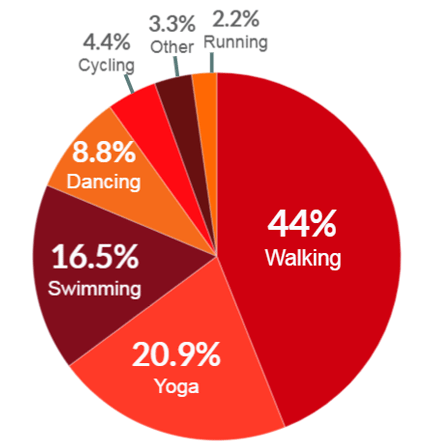How does exercise improve mood?
During exercise your brain produces more endorphins. These are the "feel-good" neurotransmitters that reduce pain and boost pleasure, resulting in a feeling of well-being. Several studies have been conducted to examine the relationship between exercise and mood. One review in particular found that after exercising, participants reported improved mood as well as decreased tension and anger.1
When you participate in exercise, adrenaline and cortisol levels fall. These hormones are released when the body is under stress. Research has suggested that there is a link between stress and low mood,2 therefore, participating in regular exercise is beneficial for your mind as well as your body!
There are a few types of exercises that can help to boost your mood, but today I'm going to focus on:
- Swimming
- Walking
- Running
- Pilates
- Dancing
- Cycling.
1. Swimming
This is a great exercise that can make your body feel more relaxed and soothe your mind, therefore, helping to reduce stress and anxiety. Also, the colour blue is associated with calmness and relaxation3 - another reason why swimming has a positive impact on your mind.
Don't panic if you don't know how to swim or if you are self-conscious as most swimming pools cater for a variety of needs and abilities, such as adult beginner lessons and female-only classes.
If you enjoy swimming, consider joining a swimming club. This is a great way to meet new people, exercise regularly and improve your swimming techniques.
2. Walking
Walking is one of the best exercises since it provides several health benefits such as, toning your legs, easing joint pain and aiding weight loss. Also, it's free and can be easily added into your daily routine!
As well as all this, walking can help to relieve stress since it gives you the time and space to think about your concerns, and come up with practical solutions to them. Taking a friend with you on your walk will provide the opportunity to talk through issues together, and get some helpful advice in return.
Walking also, of course, allows you to observe the outdoor surroundings. Spending time in nature has been found to help relieve symptoms of low mood and anxiety. Research into ecotherapy (a type of formal treatment that involves participating in outdoor activities) has found that it can help to improve mood, reduce anxiety and improve self-esteem.4
Low levels of vitamin D can also contribute to low mood. Sunlight is the major provider of vitamin D so being outdoors will help your body to absorb some of the sun's uplifting energy.
You don't have to walk for miles to feel the benefits from walking, though, as research has shown that even a brisk 10-minute walk can help to improve mood.5
If you enjoy walking, consider joining a walking group as again this is a great way to meet new people.
3. Running
Running is an aerobic exercise that increases your heart rate, as well as promoting the release of norepinephrine which improves cognitive function. Like walking, running is used in ecotherapy and can, therefore, help to improve mood and reduce anxiety. Research has found, for example, that aerobic exercises such as running can help to improve low mood.6
Just like walking, running is free and can be easily added into your daily routine! Have a look around your local area for parks or running tracks to get you started, or give a free club like Park Run a try as this is targeted at all abilities.
If running is not your thing, don't worry! There are plenty of other activities that you can do that increase your heart rate. Have a look at our page on endurance exercises for more advice on sports that get your heart going.
4. Pilates
Pilates is a form of strengthening exercise that focuses on core strength, which helps to improve general fitness and wellbeing. Pilates is associated with improving posture, muscle tone, balance and joint mobility. As well as this, it has been linked to improving mood and reducing anxiety. For example, one review found that Pilates significantly reduced low mood and anxiety symptoms.7
If you are interested in Pilates, have a look at joining a class as these are becoming more popular and are available at most gyms. If you're a beginner or if you're a little shy, you can do Pilates in the comfort of your own home through exercises such as the infamous plank! Have a look at our strength exercise videos for some inspiration.
5. Dancing
Whether you're into jazz, tap, ballroom, hip-hop, Zumba or ballet, dancing is a great exercise that is associated with several health benefits including: weight loss, better posture and improved muscle strength. Also, you can have fun moving to the music and let your creativity run wild! Research has shown that dancing can help to reduce anxiety and increase self-esteem,8 so it might be worth digging out some old records and having a boogie!
If you are interested in dancing, or want to learn some new moves, you should consider joining a dance class in your local area. If you are a little shy and enjoy your privacy why not set some time aside and dance in the comfort of your home? Look out some tunes and get moving!
6. Cycling
During exercise, tryptophan is released into the blood. As I have mentioned in previous blogs, tryptophan is converted into serotonin and then melatonin which both play a key role in controlling the sleep/wake cycle. Therefore, cycling may be a natural way to boost your serotonin levels and help you to get to sleep.
There is a complex relationship between sleep and low mood. According to The National Sleep Foundation, people with insomnia are more likely to experience low mood.9
Unfortunately, there is also a vicious cycle between poor sleep and low mood. Poor sleep can lead to worrying and stress, but worrying and stress can also lead to poor sleep. So, it might be worth going for a cycle to boost your serotonin levels avoid getting trapped in the vicious cycle of poor sleep and low mood.
Cycling can be easily included in your daily routine - you could cycle to work or go a cycle around your local park to get started.
How much exercise do you need?
It is recommended that adults should aim to do 150 minutes of moderate-intensity activity every week. You should aim to do some type of physical activity every day and reduce your time spent sitting or lying down.
What can you take away from this blog?
- Exercise is great for your mind as well as your body since studies have shown that it can help to reduce stress and anxiety and improve low mood and self-esteem.
- Aerobic exercise, in particular, has been proven to help improve mood and there are loads of aerobic exercises to choose from.
References
- https://content.iospress.com/articles/brain-plasticity/bpl160040
- https://www.theguardian.com/society/2019/oct/13/the-link-between-stress-and-depression-and-the-10-simple-words-that-could-help
- http://journals.christuniversity.in/index.php/ushus/article/view/1761/1508
- https://www.ncbi.nlm.nih.gov/pmc/articles/PMC6085576/
- https://www.ncbi.nlm.nih.gov/pmc/articles/PMC6064756/
- https://bmjopensem.bmj.com/content/4/1/e000314
- https://www.sciencedirect.com/science/article/abs/pii/S0965229917306118
- https://journals.plos.org/plosone/article?id=10.1371/journal.pone.0122866
- https://www.sleepfoundation.org/excessive-sleepiness/health-impact/complex-relationship-between-sleep-depression-anxiety
Results: Which mood-boosting exercise are you most likely to try?










